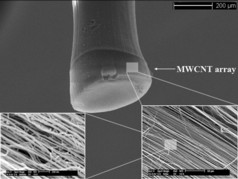Home > Press > New biosensor monitors water quality
 |
| A fabricated electrode with a grown MWCNT array (CNT post fabricated at the UC Nanoworld Lab). |
Abstract:
Cyanobacterial harmful algal blooms frequently occur in drinking water sources around the world due to eutrophication as a result of antrophogenic activities. Their presence in water is a potential threat because some species of cyanobacteria can produce and release potent toxic compounds (cyanotoxins), such as hepatotoxins, neurotoxins, and dermatotoxins.
New biosensor monitors water quality
Germany | Posted on January 9th, 2013Among hepatotoxins, microcystins (MCs) are the most frequently reported cyanotoxins and MC-LR is the most commonly occurring congener of MCs worldwide as well as in the USA. The World Health Organization (WHO) has proposed a provisional concentration limit of MC-LR in drinking water of 1 μg L-1. Therefore, there is a need for techniques to monitor MC-LR in various sources of water.
Recently, Prof. Dionysiou's group at the University of Cincinnati (UC) in the USA and his collaborators (UC and USEPA, Cincinnati, USA; and NCSR Demokritos, Athens, Greece) developed a multi-walled carbon nanotube (MWCNT)-based electrochemical biosensor to monitor MC-LR in sources of drinking water supplies.
They reported the formation of oxygen-containing functional groups on the MWCNT surface following electrochemical functionalization in alkaline solution. The performance of the MWCNT array biosensor demonstrated a marked increase of the electron-transfer resistance upon antibody conjugation. The biosensor's electron-transfer resistance showed a linear dependence on the MC-LR concentration ranging from 0.05 to 20 μg L-1. The sensing performance of the biosensor at low MC-LR concentration allows monitoring of this cyanotoxin well below the drinking water provisional concentration limit of 1 μg L-1.
####
For more information, please click here
Copyright © Wiley-VCH Materials Science Journals
If you have a comment, please Contact us.Issuers of news releases, not 7th Wave, Inc. or Nanotechnology Now, are solely responsible for the accuracy of the content.
| Related Links |
![]() Link to the original paper on Wiley Online Library:
Link to the original paper on Wiley Online Library:
| Related News Press |
News and information
![]() Simulating magnetization in a Heisenberg quantum spin chain April 5th, 2024
Simulating magnetization in a Heisenberg quantum spin chain April 5th, 2024
![]() NRL charters Navy’s quantum inertial navigation path to reduce drift April 5th, 2024
NRL charters Navy’s quantum inertial navigation path to reduce drift April 5th, 2024
![]() Discovery points path to flash-like memory for storing qubits: Rice find could hasten development of nonvolatile quantum memory April 5th, 2024
Discovery points path to flash-like memory for storing qubits: Rice find could hasten development of nonvolatile quantum memory April 5th, 2024
Nanotubes/Buckyballs/Fullerenes/Nanorods/Nanostrings
![]() Tests find no free-standing nanotubes released from tire tread wear September 8th, 2023
Tests find no free-standing nanotubes released from tire tread wear September 8th, 2023
![]() Detection of bacteria and viruses with fluorescent nanotubes July 21st, 2023
Detection of bacteria and viruses with fluorescent nanotubes July 21st, 2023
Discoveries
![]() Chemical reactions can scramble quantum information as well as black holes April 5th, 2024
Chemical reactions can scramble quantum information as well as black holes April 5th, 2024
![]() New micromaterial releases nanoparticles that selectively destroy cancer cells April 5th, 2024
New micromaterial releases nanoparticles that selectively destroy cancer cells April 5th, 2024
![]() Utilizing palladium for addressing contact issues of buried oxide thin film transistors April 5th, 2024
Utilizing palladium for addressing contact issues of buried oxide thin film transistors April 5th, 2024
Announcements
![]() NRL charters Navy’s quantum inertial navigation path to reduce drift April 5th, 2024
NRL charters Navy’s quantum inertial navigation path to reduce drift April 5th, 2024
![]() Discovery points path to flash-like memory for storing qubits: Rice find could hasten development of nonvolatile quantum memory April 5th, 2024
Discovery points path to flash-like memory for storing qubits: Rice find could hasten development of nonvolatile quantum memory April 5th, 2024
Water
![]() Taking salt out of the water equation October 7th, 2022
Taking salt out of the water equation October 7th, 2022
|
|
||
|
|
||
| The latest news from around the world, FREE | ||
|
|
||
|
|
||
| Premium Products | ||
|
|
||
|
Only the news you want to read!
Learn More |
||
|
|
||
|
Full-service, expert consulting
Learn More |
||
|
|
||








